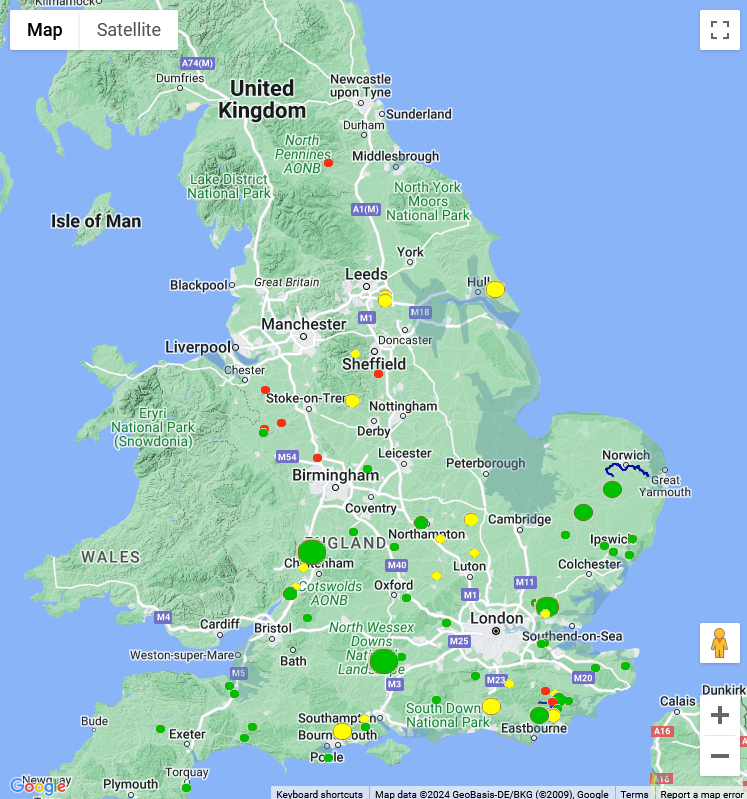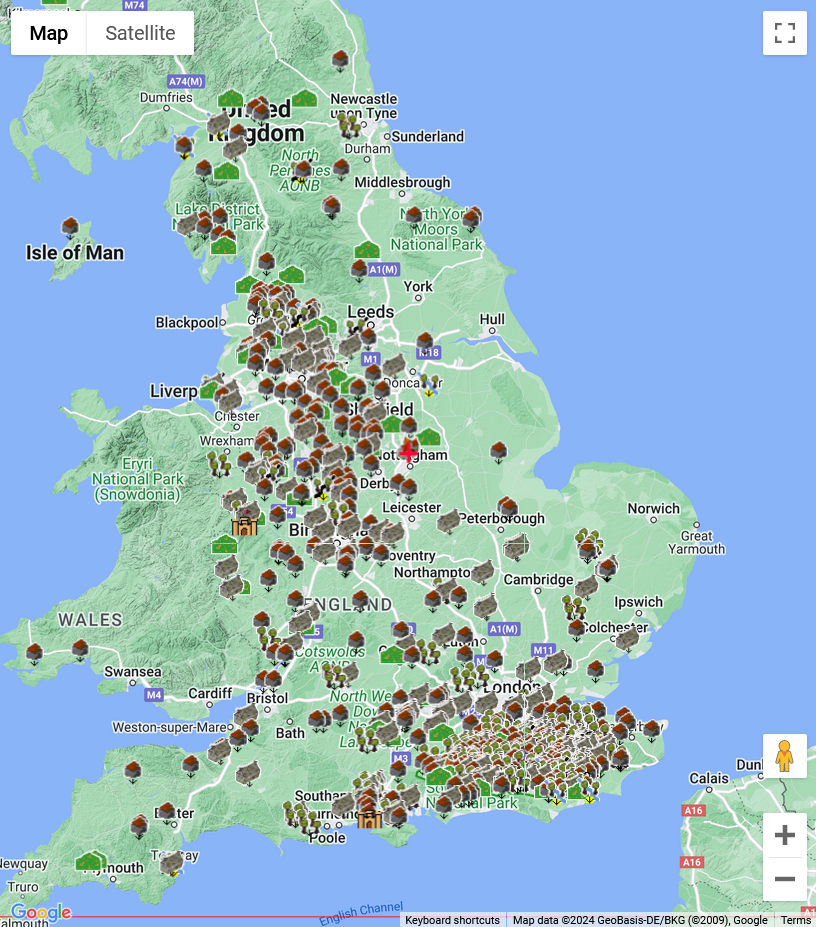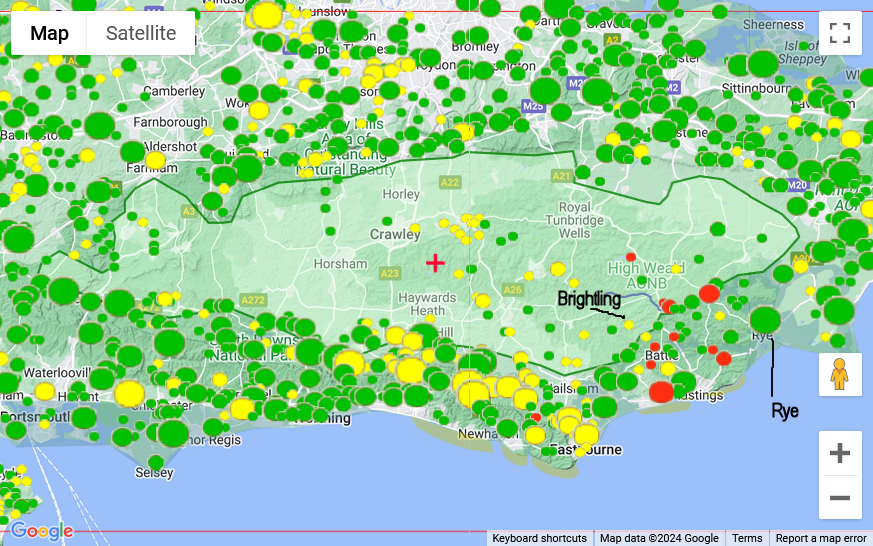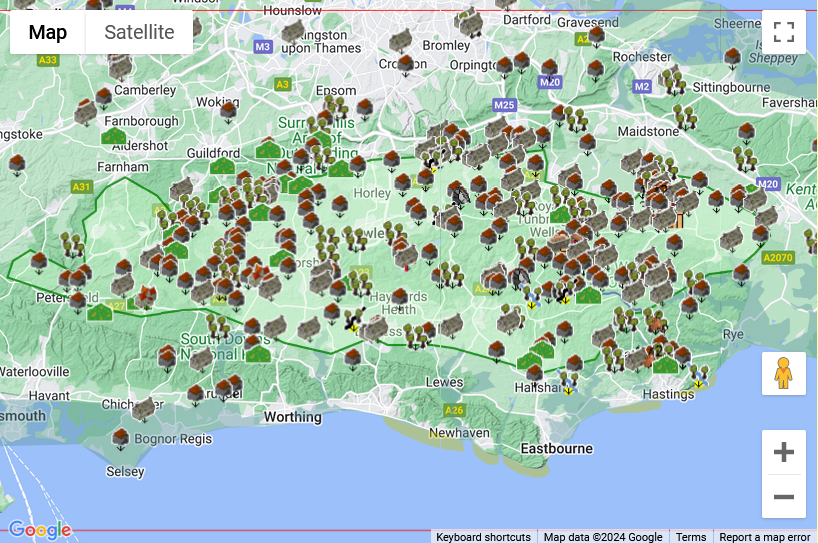|
 | Anglo Saxon History |  | |
| | Places containing the snippet Hurst |
|---|
| |
|---|
| Place Name theory background |
|---|
My current theory on Saxon Place Names
I have was looking at the place names around Hastings, which all appear to be Saxon, with a very few exceptions.
My research leads me to conclude that this area was settled between the take over of Kent by Henghest and Horsa, and the
take over of the South Downs area by Aelle, so around 465AD.
As a lot of villages have similar snippets in their name and I wondered if each of these meant something, and that this
in turn might mean that the settlement names described the use or surroundings of a place.
So what could these snippets mean ??
My conclusions may seem surprising but please read ~~link~Snippet 1 - what is an island, eye etc ~snippet_eye~~ before
reading any other snippet pages as this explains the reason for the '4.5 metre line' described in other snippets.
| | |
|---|
| Table of Contents for Hurst |
|---|
| | Does the Hurst snippet in Saxon village names mean a wood ? ▲ |
|---|
The current etymology(derivation) of the snippet hurst
From Wiktionary:
From Middle English hirste (“wood, grove; hillock; sandbank, sandbar”), from Old English hyrst (“hillock,
eminence, height, wood, wooded eminence”), from Proto-West Germanic *hursti; akin to Dutch horst (“thicket; bird's
nest”), German Horst (“thicket, nest”).
From Etymonline:
"hillock" (especially a sandy one), also "grove, wooded eminence," from Old English hyrst "hillock, wooded eminence,"
from Proto-Germanic *hursti- (see horst). Common in place names (such as Amherst).
From localhistories.org:
Hurst meant a wooded hill.
From the 'Oxford Illustrated Dictionary 1981':
Hurst - Hillock; sandbank in the sea or river; wooded eminence; wood;
From the Anglo-Saxon Dictionary online':
Hyrst - a hurst, copse, wood.
From the above different etymologies it would seem that a hurst could be a wood.
| | What history do we have for the hursts ▲ |
|---|
There appear to be a lot of settlements with the snippet hurst in my local area, but the only early records for these
settlements appear in the old church records. Lets look at some of the hursts in my area which is along the Kent and
Sussex Borders. The examples I will be using as a sample run along the old ridgeway from Newenden to Wadhurst and see if
there are any references we can use.
These consist of the churches of Sandhurst, Hawkhurst, Ticehurst and Wadhurst.
The history of St Michael's
Sandhurst
1175 - First mention of Sandhurst
1220 - First mention of a chapel in Sandhurst
The history of St Lawrence Hawkhurst
It is likely that there has been a church on this site from at least 1100, maybe earlier, when Hawkhurst belonged to
the Abbot of Wye, and then of Battle, given to him by William the Conqueror as part of his thank-offering after the
Battle of Hastings. The first mention of the building is in a Charter of 1285 and the first Rector whose name we have is
Richard de Clyne in 1291.
The history of St Mary's
Ticehurst
In the year 1018 King Cnut made a grant to Aelfstan, Archbishop of Canterbury of “a certain little woodland pasture
in the famous wood of Andredeswealde which is commonly called Haeselersc…” The name survives today as Hazelhurst
Farm in Ticehurst parish.
The Domesday Survey which started in 1086 does not mention Ticehurst, but it refers to “Hasslesse” (again
Hazelhurst).
The earliest reference to Ticehurst is in a document of 1180 relating to Combwell Priory and mentions “Adam, Presbyter
de Tychenherste. In 1197 the church at Ticehurst is confirmed as coming under Hastings Priory.
The history of St Peter & St
Paul Wadhurst
The church dates from the early 12th Century. It is situated in the centre of Wadhurst, just off the main street. Built
of sandstone, the tower is from 1100, and its fine shingle spire, recently restored after gale damage, dates from the
14th Century.
From the above records it would seem that hursts are mentioned in the Domesday Book from 1086AD, but
not the villages listed, and that these were founded before the 1100's.
| | The Domesday book 1086AD ▲ |
|---|
The Domesday Book was created for William the Conqueror to enable him to asses taxes.
Let us now look at the 'hursts' mentioned in the Domesday book for Sussex and Kent to see if this shows any suggestions.
| | |
|---|
A map of all the Hursts mentioned in Domesday ▲
|
|---|

This map is based on Google maps using their API, and shows all the Hurst's mentioned in Domesday, there are very few,
this is odd as we observe a large number in this area today. The dot sizes show relative population size, green shows
undamaged settlements, yellow damaged, and red destroyed.
The data for this map is derived from the Open Domesday website
This is the first free online copy of Domesday Book. The site was built as a non-profit project by me, Anna
Powell-Smith, using data created by Professor J.J.N. Palmer and a team at the University of Hull.
|
A map of all the modern Hursts ▲
|
|---|

This map is based on Google maps using their API, and shows all the Hursts mentioned in the Ordnance Survey Open Names dataset.
There appear to be two main clusters of hursts, one in the South East, the other in the West Midlands area.
|
A map of all the South Eastern Hursts mentioned in Domesday ▲
|
|---|

This map is based on Google maps using their API, and shows all the Hurst's mentioned in Domesday, as is obvious there
is a large empty area in the Wealden area. The circle size shows the relative settlement sizes, Brightling is described
as having a population of 12, and Rye a population of 189. Red circles are destroyed villages, yellow damaged and green
unaffected by the invasion.
The data for this map is derived from the Open Domesday website
This is the first free online copy of Domesday Book. The site was built as a non-profit project by me, Anna
Powell-Smith, using data created by Professor J.J.N. Palmer and a team at the University of Hull.
| | Is there anything this boundary in Domesday could represent ▲ |
|---|
The Anglo Saxon Chronicles 892AD - the Viking large army.
This year went the large army, that we before spoke about, came from a kingdom in the east, westward to Bologne; and
there were shipped; so that they transported themselves over at one time with their horses withal. And they came up with
two hundred and fifty ships into the mouth of the Limne, which is in East-Kent, at the east end of the vast wood that we
call Andred.
This wood is in length, east and west, one hundred and twenty miles, or longer, and thirty miles
broad. The river that we before spoke about comes out of the weald.
On this river they towed up their ships as far as the weald(wood). Four miles from the mouth of the river they destroyed
a fort within the fen(possibly near Burmarsh - Burh Maersc the marsh fort), whereon sat a few churls, and which was
hastily wrought. Soon after this came Hasten up with eighty ships into the mouth of the Thames, and wrought him there a
work at Milton. and the other army went to Appledore.
So we have a large forest 120 miles long by 30 miles wide covering the area which is the approximate
size for the boundary we have drawn.
| | |
|---|
A map of all the modern Hursts in the South East ▲
|
|---|

This map shows the modern hursts in the South East of Britain, and as you can see the majority of hursts line inside the
green boundary.
| | Timescales for the Hursts ▲ |
|---|
From our above maps and dates, it would seem that a majority of the hursts in the South East were settled after Domesday
1086AD and before 1100AD. The only event
during this time that was large enough to provide a large enough population migration to settle these villages was the
Battle of Hastings in 1066AD.
| | Conclusion ▲ |
|---|
We can now see that our question 'Does the Hurst snippet in Saxon village names mean a wood ?' was not correct at
the time the settlements were created, and that a better original definition of the Saxon word hyrst would be 'a
clearing in a Forest'.
So over time the original meaning of the word has been completely reversed and it now means a wood or copse.
| | Loose Ends ▲ |
|---|
If we make the assumption that a hurst is 'a clearing in the forest', this then implies that the Forest Of
Andredsweald was larger before Domesday, and that the settlements shown in Domesday are very early Saxon settlements.
This would also mean that this Forest was being cut down to provide fuel, or construction materials for earlier Saxons
and also by the Romans from the Hastings and Pevensey areas, so theoretically it would be possible to estimate the
annual reduction in Forest size.
The other implication is that if the forest was only being eroded from this direction then the Hastings and Pevensey
areas were major construction/industrial areas , and the proximity both to the Forest and sea were of major importance
for Romans and Saxons, which implies in turn shipbuilding.
Please read our The Great Forest of
Andredsweald - Anglo Saxon Chronicles page for more details on the Forest.
|
|
|
|
|
| |
|
|
Local Interest
Just click an image |
|
|
|
|
|
|
|
|
|
|
|
|
| |
|
|